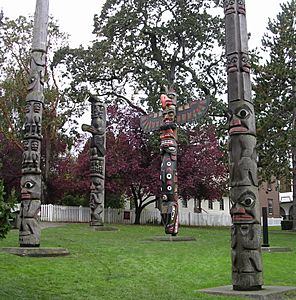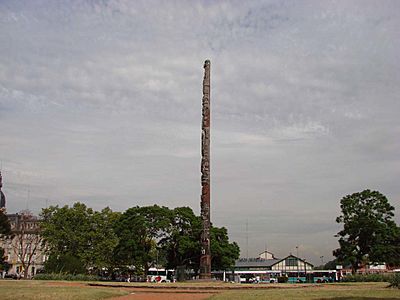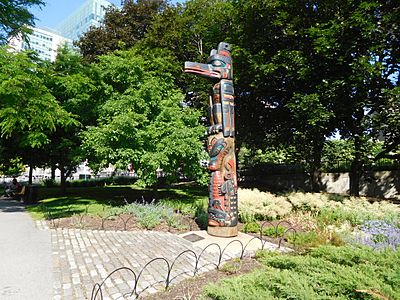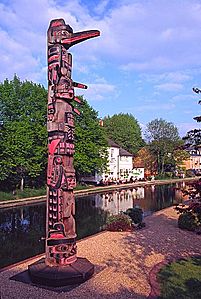Henry Hunt (artist) facts for kids
Quick facts for kids
Henry Hunt
|
|
|---|---|
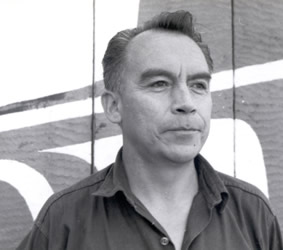 |
|
| Born | 16 October 1923 Fort Rupert, British Columbia, Canada
|
| Died | 13 March 1985 (aged 61) Victoria, British Columbia, Canada
|
| Nationality | Canadian |
| Known for | Totem pole carving |
| Style | Kwakwakaʼwakw (Kwakiutl) |
| Spouse(s) | Helen Martin |
Henry Hunt (born October 16, 1923 – died March 13, 1985) was a talented First Nations woodcarver and artist. He belonged to the Kwakwaka'wakw people. This group is from the coast of British Columbia, Canada. Henry Hunt was famous for carving many totem poles. You can see his totem poles in public places in Canada and other countries.
Contents
Henry Hunt's Early Life
Henry Hunt was born in 1923 in a community called Fort Rupert in British Columbia. He was a descendant of a well-known researcher named George Hunt.
Before becoming a professional carver, Henry worked as a logger and a fisherman. In 1939, he married Helen Martin. Helen was the adopted daughter of another famous Kwakwaka'wakw artist, Mungo Martin. Henry and Helen had several children who also became artists. These included Henry Jr., Shirley Ford, Tony Hunt, Richard Hunt, and Stanley C. Hunt.
In 1954, Henry Hunt moved to Victoria, British Columbia. There, he became the main assistant to Mungo Martin in a special carving program.
Becoming a Master Carver
Henry Hunt began working with his father-in-law, Mungo Martin, in Victoria in 1954. He became Mungo Martin's chief assistant at Thunderbird Park. This park is part of the British Columbia Provincial Museum.
At Thunderbird Park, Henry learned traditional wood carving skills. He was taught by Mungo Martin and Arthur Shaughnessy. He also helped to fix and care for Aboriginal art in the museum's collections.
When Mungo Martin passed away in 1962, Henry Hunt took over his important role. He became the park's Master Carver.
Henry Hunt taught his own sons, Tony, Stanley, and Richard, how to carve. All of them later became successful carvers. Tony became his father's main assistant. Together, they created many important totem poles and other carvings. Henry Hunt worked at the museum for more than 20 years. He retired in 1974, and his son Richard became the new Master Carver at Thunderbird Park.
Famous Works of Art
Henry Hunt followed the traditional Kwakwakaʼwakw carving style. He used deep cuts with old tools and only a little paint.
You can see many of Henry Hunt's artworks across Canada. Many of his totem poles and other beautiful objects are on display at Thunderbird Park in Victoria. He carved a totem pole for the Indians of Canada Pavilion at Expo67 in Montreal. He also made a pole for the Totem Marina at Shuswap Lake, British Columbia.
One famous work by Henry and Richard Hunt is a 32-foot (about 9.75-meter) memorial pole. It was put up in 1970 to remember Mungo Martin at Alert Bay. This pole is said to be the world's tallest totem pole. Before this, the tallest was a pole carved by Henry Hunt, Mungo Martin, and David Martin. That pole stands in Beacon Hill Park in Victoria. It tells the story of Geeksen, the first man in Kwakwaka'wakw stories.
Another one of Hunt's poles is at the Swartz Bay ferry terminal. This pole shows two Kwakwaka'wakw mythical figures: the Grizzly Bear and the Whale. It won first prize in a contest called "Route of the Totems."
You can find more of Hunt's works in Victoria, at Victoria Harbour, and at the entrance of the Royal British Columbia Museum. Other works are at the Maritime Museum of British Columbia in Vancouver. You can also see his art at the Museum of Anthropology at UBC in Vancouver. And there's a pole in Confederation Park, Ottawa, Ontario.
Henry Hunt also made many smaller artworks. These included small presentation poles, about 45 centimeters long. These were given as gifts to important visitors and leaders. Some people who received these gifts were Prime Minister Lester Pearson, U.S. President Lyndon B. Johnson, and Queen Elizabeth II.
Some of his works have been shown in other countries too. Henry Hunt totem poles are on display in the Plaza Canadá in Buenos Aires, Argentina. Another one is in the town of Berkhamsted, England.
- Works
-
Feast dish in the shape of Dzunukwa, Museum of Anthropology at UBC, Vancouver
Later Life and Passing
Henry Hunt passed away on March 13, 1985, in Victoria. He was buried in Hatley Memorial Gardens, located in Hatley Park.



